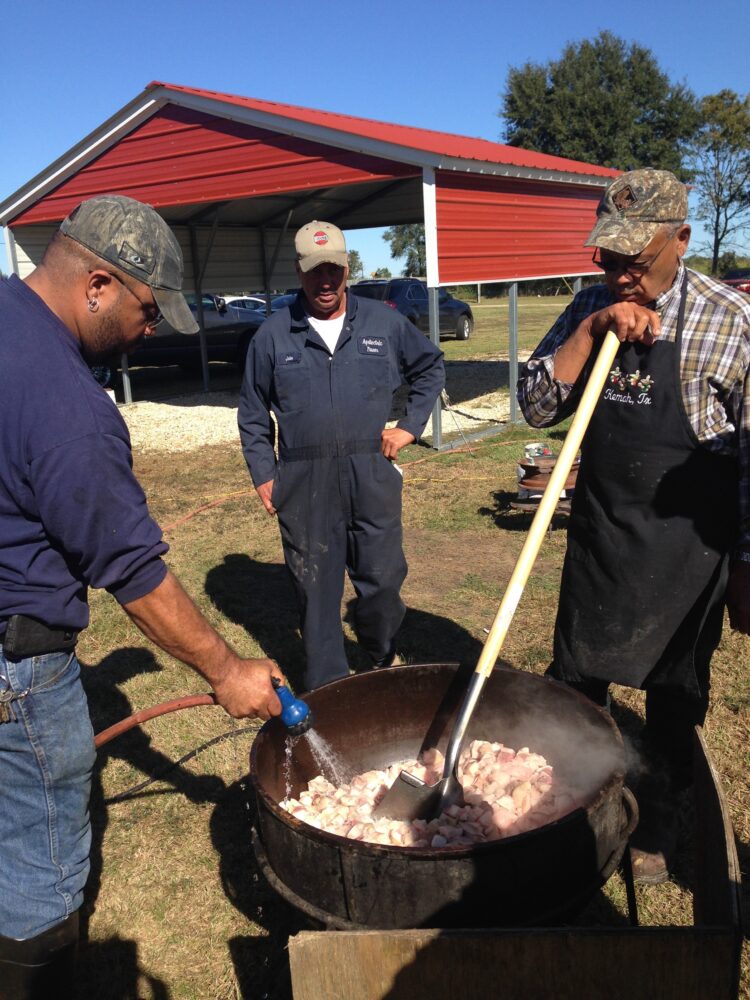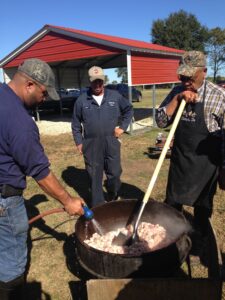Nose to Tail
A foodway born out of necessity is maintained as a tradition
Published: November 29, 2022
Last Updated: February 28, 2023

Photo by Alexandra Giancarlo
Jevon Hawkins, John “Ricky” Guillory, and Donald Cravins, Sr. prepare a pot of cracklins.
Before refrigeration and widespread grocery stores, families and neighbors came together on a rotational basis to undertake a task too difficult to do alone. The various parts of the hog were deftly cut, cooked over a fire, stuffed into casings, twisted into links, placed in jars under the house, or hung in a smokehouse—any way to ensure meat would be available throughout the lean months of the winter or when work was scarce. The origins of the boucherie in some Creole families and communities could stretch back to the slavery era, during which time their ancestors learned to turn the least desirable cuts of meat into something not only edible, but delicious. Jevon Hawkins explains: “You know, the way I understand it and the way I feel about it, boudin came from the trash of the hog. And that was stuff that the slave owner didn’t want, you know?” From nose to tail, every possible part of the hog was used and nothing wasted. As Don Cravins Sr. sees it, “boucheries were born out of necessity. They were taken very seriously. Weeks of preparation went into making sure all the tools were in place, crock jars were ready for the salt meat, wood for the cooking, pots and utensils in order, all as they prepared to share their bounty with the community. With that kind of love and meticulous preparation the food couldn’t help but be special.”
Born of necessity, the tradition evolved over the decades, and possibly centuries, as Creole families continued to cope with tough times by coming together and working hard to provide their kin with meat. As it evolved, the boucherie also meant companionship, storytelling, laughter, and the reinforcing of familial and community bonds. In Goldman Thibodeaux’s memory, “We’d catch up, taking a break. Play a little music. And if they didn’t have [any] music, they’re laughing, talking about jokes, and having a good time … but the work was going on!” Marie Mouton explains that, in her memories of boucheries, “everybody was telling jokes and just getting along and [there was] a whole lot of laughter and fun, you know?” Demi Thomas explained the atmosphere at boucheries growing up: “We’d be in the yard, music blaring, everybody just listening and hollering every now and then and singing a little to their favorite song. … I wish I could go back sometimes, just to have that feeling.”
One must be both an early riser, and a person of considerable stamina, to experience the boucherie from start to finish. By daybreak, the actual butchering of the hog is likely complete, though the processing of the meat will stretch throughout much of the day. At the annual Cravins family and friends boucherie held near Mallet, a team of close to a dozen men works seamlessly through the complicated steps of killing, draining, scalding, scraping, and butchering. These initial hours of high concentration give way to a more jovial atmosphere by around 8:30 a.m. Zydeco music drifts through the backyard speakers as various workstations are set up to begin cutting the skin for crackling, seasoning the ribs, and the like. The physically demanding tasks tend to fall to male attendees, who have usually learned the required skills from years of watching their older brothers and fathers while serving as errand boys, before being promoted to, or “inheriting,” a specific role such as scratching the hair off the hog. Many of the men present at the Cravins boucherie have seen four, even five, generations of the tradition and its evolution. In Creole culture, culinary skills are not exclusively the domain of women but are highly valued in men as well, and both men and women partake in cooking throughout the day. Women are often the boudin-makers and might also be in charge of serving coffee and of making a late-day meal for those in attendance.
Today, boucheries honor the legacy of their ancestors and pass the tradition along to the next generation. Wayne Singleton—of the band Wayne Singleton and Same Ol’ 2 Step—noted, “We mainly do it for tradition. We can easily go buy [meat] at the store, but I’d like for my kids to experience the same things that I did.” Boucheries also serve as a homecoming and as a cultural touchstone for relatives and friends who have moved out of state. Many speak of the ritual as a way to celebrate what they see as foundational Creole values: pride in cultural identity, family, and in the self-sufficiency and ingenuity of their ancestors. Mona Cravins explained that, although her family had little money growing up, “there was always something to eat. You never thought about there not being money. I am sure there are many times that there wasn’t.” Similarly, according to Lloyd Mitchell, cooking and sharing food—making it stretch if needed—is “just how we were raised.”
Many Creoles describe the modern-day, twenty-first-century boucherie as a celebratory reunion, and this jubilant mood prevailed at the Cravins’s annual event, topped off with live zydeco music. Carl Arthurlee affirmed that it is, indeed, a celebration: “Invite the community. Everybody come down and lend a helping hand. Let’s do it and have fun and make the day.”
The authors would like to thank the southwestern Creole communities for their assistance with this article.
Alexandra Giancarlo, PhD, is a multidisciplinary settler scholar and assistant professor in the Faculty of Kinesiology at the University of Calgary, Alberta, with a specialization in socio-cultural studies of sport and physical culture. She has been working with southwestern Louisiana Creole communities since 2016.
Dustin R. Cravins is a noted Creole cultural advocate, co-host of the long-running Cravins Brothers Zydeco radio show, and a partner at La Louisianne Consulting, a governmental relations, business development, and public relations firm. Owner of Cravin’ Boudin Food Truck, he has been recognized as an expert and a “mover and shaker” for his contributions to Louisiana culture and politics.
